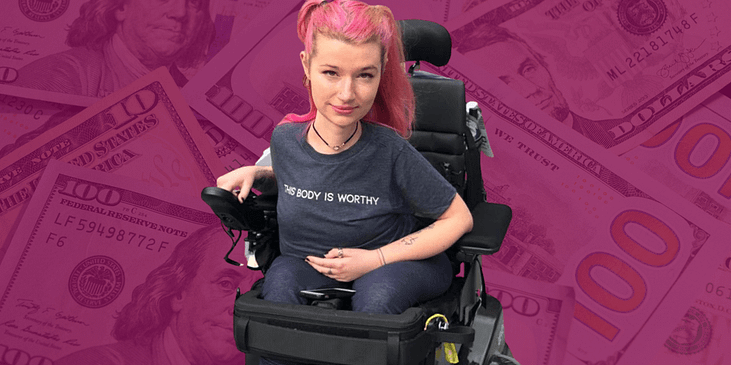By Hannah Soyer
I remember, once, during a 7th-grade class trip to Washington D.C., I tried to get an accessible taxi from the museum back to my hotel. I was tired and needed to get out of my wheelchair. When my mom, my helper, and I learned how much this taxi ride would cost, however––$250 for less than a 20-minute ride––we decided to wait for the bus which would take everyone back to the hotel together. This is just one example of the high cost of living with a disability, proof that access rarely is financially accessible.
The Costs
The most obvious expenses related to disability are costs associated with healthcare, mobility aids, or other assistive technologies needed for someone to live. It is often assumed that these needs––from prescriptions, to surgeries, to wheelchairs, to hearing aids––are covered by insurance, and while this is sometimes the case, it’s not a guarantee. Hearing aids, for example, are not considered “medically necessary,” and are therefore rarely covered by any insurance (although they are covered to an extent for children, in some states). Some wheelchairs are covered, but usually only to an extent, and sometimes not at all depending on your needs. What an insurance company decides is “necessary” seldom reflects someone’s reality, and since these are necessary, disabled people often face paying out of pocket if they are able to, or choosing which need they are able to afford for that week/month/year. It goes without saying, but to sacrifice a healthcare need means putting one’s health at risk. If you can’t afford to pay for all of your needs and have to choose between, say, a specific prescription and a hospital bill, this risk is not a choice, it’s being stuck between a rock and a hard place.
Disability impacts nearly every aspect of someone’s life, and as such, there are hidden costs related to each of these intersections of daily life: transportation, housing, food, care. The cost of a wheelchair-accessible taxi in D.C. at that time was outrageous. The costs to purchase a wheelchair-accessible van is also very expensive, on average, they range from $40,000 to $100,000. Public transportation is great, but only if all aspects of it (every city bus, every subway stop) are fully accessible, and only if you live close to a stop. This is much more likely if you live in a city––it’s likely you’ll be able to access more places without even taking a bus or train, too. But there is a drawback, one which should be familiar by now: higher costs.
When I was living in my own apartment in two different cities, I paid anywhere from $800-1500/month for an accessible place that worked for my needs. That’s roughly $500-1000 more than what my peers who did not have my same access needs paid in monthly rent. Because accessible apartments often only exist in newer buildings, rent is usually always higher than a comparable complex in the same area. And yes, these new buildings are often nicer with more amenities, but this isn’t a luxury I’m paying more for because I want a nicer apartment, it’s simply the cost of a unit I can physically access and that works for my mobility needs.
Now, let’s talk about care. I rely on caregivers nearly 24/7, and currently receive funding for my caregivers through two different sources, the Medicaid waiver I am on, and a county service that pays for caregivers related to my employment. The county service operates on a sliding scale, so that once I begin making $38,000 a year, I will have to pay for everything they cover. This scenario alone, of having to cover the hours of care I need not taken care of by Medicaid, would leave me with less than $10,000 to live on for an entire year. This is assuming I would reimburse my caregivers at the rate currently paid by the county, which is barely a living wage to begin with.
For some disabled people, food can also be an added expense. If someone has specific dietary needs, they may need to purchase food that is significantly more pricey, from significantly pricier stores. If someone also has a disability that precludes them from being able to go grocery shopping and they rely on food delivery, the costs only go up.
The Problem
Maybe such high costs wouldn’t be an issue if most people with disabilities were part of the top 1%, or even the top 10% of financial affluence. But for most of my community, this simply isn’t the case. In the U.S., the 2021 employment rate of people with disabilities was 19.1%, compared to a 63.7% employment rate of those without disabilities. There are a multitude of reasons for such a high discrepancy, including inaccessibility of jobs, employer bias against disabled workers (the belief that we just won’t be able to perform as well, for example), and the sheer fact that the labor market is made to profit off of bodies and minds that work a very specific way.
On top of this, many disabled people have a very real fear of losing benefits such as Supplemental Security Income (SSI) or Medicaid if they earn too much in wages or get married. The fact is that there is no straightforward, easily understandable, accessible way to navigate this. You have to know the right people and say the right thing and ask the right questions, and even then there might be no solution. Remember the hours of care I get covered through the county? I will lose these hours the minute I start making a living wage.
The Way Forward
Some may point out that disability-related expenses are high for a reason. Vehicles, for example, cost more to adapt for wheelchairs, and it therefore makes sense that a wheelchair accessible van would be so much more expensive than a standard minivan. But this is just one way to think about the distribution of cost. In Chicago (among other cities), nearly all taxis are wheelchair accessible, and they do not cost any more than a taxi without modifications. This is often due to accessible taxis being subsidized by a city––even D.C. (where I once tried to get an accessible taxi for $250) now subsidizes their accessible taxis. This demonstrates a shift in perspective of what is necessary, and what must be prioritized.
But lowering the cost of accessibility won’t fix everything. In order for disabled people to actually be able to access what we need, we have to be able to earn a salary with no fear of losing benefits. This means making more resources which explain how income impacts benefits easily understandable and accessible. It means ensuring disabled people have access to all the information they need to navigate this process, and someone (like a knowledgeable and skilled benefits planner) to guide them through the steps. It also means eliminating wage caps and realizing that the benefits disabled people receive are benefits they rely on for their health and care. Really, it comes down to trusting disabled people and those who know them best to decide what is “medically necessary” (like, for example, hearing aids), and then shifting our world’s financial priorities to reflect this.

Hannah Soyer is a Freelance Writer for WID.


0 comments on “The High Cost of Disability: The Inaccessibility of the Cost of Access”